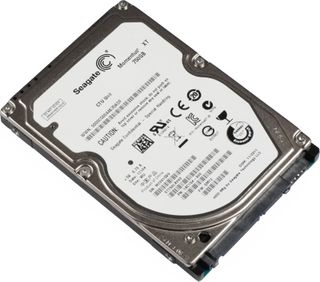Momentus XT 750 GB Review: A Second-Gen Hybrid Hard Drive
When a little bit of flash memory is good, more must be better, right? Seagate's second-generation Momentus XT hybrid hard drive is out to compete with SSDs, even as it delivers capacities typical of laptop-oriented 2.5" mobile disks.
Momentus XT (ST750LX003) In Detail
Seagate's new drive family still spins at 7200 RPM. However, throughput is up. Maximum capacity increases from 500 GB to 750 GB, which is really pretty generous for a mobile platform. And, if you don't need that much capacity, there's still the first-gen 500 GB model limited to SATA 3Gb/s connectivity.
As someone with a keen interest in power consumption, it would have been interesting to consider a lower-capacity drive based on a single-platter design. However, this would chip away at the point of this product: lots of space and SSD-like performance from a single storage device.

Single-Level Cell NAND Flash
As with its predecessor, Seagate's new Momentus XT employs single-level cell (SLC) flash memory.
Of course, most of us are more familiar with multi-level cell (MLC) NAND, which is much more economical for building SSDs. However, we've seen specific products, like Intel's SSD 311, capitalize on the performance and reliability advantages of SLC flash at smaller capacities, too. The same strategy applies here: use a little bit of SLC memory to a greater effect.
Modern controllers do a great job of spreading writes out across NAND, a process referred to as wear leveling. But this is only possible when the drive's total capacity isn't consumed. When there aren't any blocks available to use for shuffling data around, though, MLC flash can wear out much faster. So, Seagate's decision to go with SLC for its cache is a smart call.
Apparently, the company saw fit to increase the cache's capacity, too. Whereas the previous model included 4 GB of SLC memory, this one sports 8 GB.
Stay on the Cutting Edge
Join the experts who read Tom's Hardware for the inside track on enthusiast PC tech news — and have for over 25 years. We'll send breaking news and in-depth reviews of CPUs, GPUs, AI, maker hardware and more straight to your inbox.
Firmware Upgrades: Boot Data-Pinning And Write Caching
The ST750LX003 sports two firmware-based improvements compared to its predecessor. First, the company says that it now permanently pins system files associated with the boot process into cache, speeding that up substantially. We can confirm that this works; Windows 7 starts up in the time we're used to seeing from popular many popular SSDs. Seagate claims that the algorithm behind this feature identifies and learns boot activity to effectively pin the right data into the flash-based cache. As a result, its effect should be felt on any operating system, including Mac OS X. A quick check with a Windows XP install confirms this. Because boot data is typically executed in the same order over and over (especially compared to user activity), the premise behind this technology makes sense.
Additionally, writes are now cached as well. Although the write speed of the flash Seagate is using is specified for 100 MB/s (reads are up to 170 MB/s), this could be helpful for speeding up random transfers, which hard drives really struggle with on their own. Unfortunately, we can't confirm the validity of this second addition. Testing a number of different benchmarks, multiple times, didn't reveal any notable performance gains.
Independence: Good For Upgrades?
The fact that the Momentus XT proffers its full feature set, regardless of operating system, means that you can install the drive into any older notebook or desktop PC with a SATA interface and not worry about compatibility. NCQ support is, of course, helpful. But the self-learning algorithms are contained within the drive and able to work with any host system. The only foreseeable concern is the Momentus XT 750 GB’s 4 KB sector size. Fortunately, Seagate employs 512-byte emulation.
Current page: Momentus XT (ST750LX003) In Detail
Prev Page Seagate's Momentus XT Picks Up FAST Technology Next Page Test Setup And BenchmarksMost Popular

